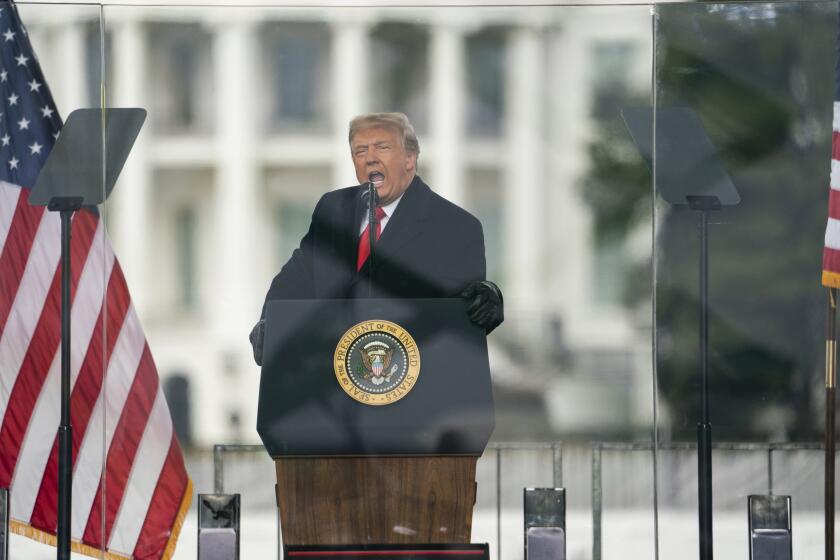Could Trump really cut off wildfire aid for California? Absolutely

- Share via
Donald Trump has repeatedly threatened to cut off federal disaster aid for California’s wildfires if he returns to the White House, most recently at a campaign rally in Coachella and in remarks at his golf course in Rancho Palos Verdes.
Such a loss in federal funds would be a devastating blow to a state where wildfires have grown larger and more destructive in part due to climate change. A single severe fire season can rack up tens of billions of dollars in damage, firefighting costs and economic losses. The prospect of losing disaster aid has state officials and politicians mulling contingency plans ahead of next week’s election.
“This falls into Trump’s revenge agenda,” said Rep. John Garamendi (D-Walnut Grove). “He has promised revenge on those who did not support him, or who challenged him, California being one of several states.”
Trump has said he’ll withhold disaster funding if state officials don’t back his policies — most recently threatening to do so if Gov. Gavin Newsom doesn’t make more water available to farmers and homeowners.
“We’re going to take care of your water situation, force it down his throat, and we’ll say: Gavin, if you don’t do it, we’re not giving any of that fire money that we send you all the time for all the fire, forest fires that you have,” Trump said in Coachella.
The threats appear to be founded. Presidents have an extraordinary amount of discretion when it comes to disaster aid, which Trump reportedly wielded as a political cudgel during his presidency.
He initially refused to approve federal aid to California for wildfires in 2018 until a National Security Council staffer showed him that Orange County had a dense concentration of supporters, according to a report from Politico’s E&E News. Trump also ignored a 2020 request for aid for Washington state fires amid a feud with Gov. Jay Inslee, with the funds greenlighted only when President Biden took office months later, the outlet reported.
“We are building a track record of this kind of behavior becoming more than a threat,” said Brian Rice, president of California Professional Firefighters. “It is appearing to be a potential reality. And it’s very concerning.”
The California firefighters association endorsed Democratic Vice President Kamala Harris — breaking from its national union, which did not back either candidate — in part because of Trump’s threats.
Former President Trump has again questioned U.S. election integrity, claiming without evidence that Democrats are cheating in the presidential race. Experts condemned the rhetoric.
California and other states receive most federal wildfire aid through the Federal Emergency Management Agency in a process dictated by the federal Stafford Act and a regulatory framework that implements the law. That includes individual assistance — direct payments and services to homeowners and renters whose properties were damaged — and public assistance, which pays for things such as search-and-rescue teams, debris removal and infrastructure repair.
In order to qualify for such aid, a state must show that an incident is of such a severity and magnitude that a response is beyond the state’s capability. The governor must request, and the president must declare, a major disaster and then approve whatever aid the governor requests.
This is done through a step-by-step process in which local, state and federal governments assess damage and make sure they meet certain financial thresholds. Based on that information, FEMA decides whether a federal disaster declaration is warranted and issues a recommendation to the president. In the past, presidents have followed that recommendation, but there’s nothing in the law that requires them to do so.
Similarly, presidents are not legally compelled to consider certain factors when making a decision on disaster aid, and there’s no requirement that they do so in a timely manner.
States can appeal a denial of aid, but the president ultimately decides on the outcome of the appeal, said Matt Sedlar, climate analyst at the Center for Economic and Policy Research, who has studied how disaster relief funds are apportioned
“My main message is, yes, absolutely, bad things can happen to California, if Trump acts on his threats,” he said.

A denial of FEMA-recommended disaster aid would generate political fury and probably result in a lawsuit on the basis of the decision being arbitrary and capricious, said Garamendi, who sits on the Subcommittee on Economic Development, Public Buildings, and Emergency Management, which conducts oversight of FEMA. But it’s unclear how the courts would rule.
“It would be a hell of a stink from members of Congress and Senate putting a lot of pressure on the president, particularly given what Trump has said is his agenda,” Garamendi said. “I guarantee that would happen: political blowback and a lawsuit.”
All states are susceptible to hazards, ranging from storms and floods to fires and even terrorist attacks, that would make them eligible for federal assistance. Officials fear Trump would base his decisions on whether to approve aid on a state’s political leanings — for instance, by denying assistance to California or Washington while approving money to states where his campaign had strong support.
After Hurricane Michael hit Florida in 2018, Trump directed FEMA to pay 100% of most of the state’s disaster costs instead of the customary 75%, resulting in $350 million more in federal assistance than the state would have received without intervention, Politico reported.
According to Gov. Ron DeSantis’ autobiography, when he asked Trump for help, the then-president replied, “I must have won 90% of the vote out there. Huge crowds. What do they need?”
Trump’s visit to the home state of his opponent, Vice President Kamala Harris, offers him a chance to bash the liberal policies of the Bay Area native.
California has been denied federal money for wildfires in the past. In 2021, state officials spoke out when Biden declined to make available individual assistance to victims of the Caldor fire, which destroyed more than 1,000 structures in the Sierra Nevada. The president did declare a disaster and approve public assistance. But Biden’s decision was based on — not in spite of — a recommendation from FEMA, which said it had considered the amount of destruction, residents’ insurance coverage and income levels and the fiscal resources of the state before determining the fire did not warrant individual aid.
There is at least one notable exception: Fire management assistance grants, which provide federal funding for up to 75% of eligible firefighting costs for major wildfires, do not require presidential approval. They must be approved only by a regional FEMA administrator. The agency has approved nine of those grants to California this year so far.
Still, FEMA’s director and regional administrators are appointed by the president, making it possible Trump could install officials who would carry out his wishes.
“There are many mechanisms by which the federal government can hurt a state,” Sedlar said.
Experts believe that if a president rejects providing federal aid, state officials would seek alternatives. Some aid may continue to be available through other federal agencies such as the Department of Transportation, which could help with rebuilding highways, putting up road barriers and cleaning culverts, Garamendi said.
But the ultimate burden to make up the difference would fall on California, he and others said, raising the possibility of cuts to other programs or funds to come up with the money.
Newsom recently told Politico that he’s working with other officials to create plans in the state budget for an account California can draw from to pay for disaster response, in the event FEMA aid is no longer available under a future Trump presidency.
“You’re going to have serious cash flow issues even in a state as large as California, even with budget reserves that are significant,” the governor told the outlet.
President Biden appeared to call supporters of former President Trump ‘garbage.’ He then said he only meant the racism on display at Trump’s New York rally was garbage.
California’s need for federal disaster assistance over the next four years is virtually guaranteed. Requests for federal aid are a routine occurrence, to deal with not only worsening wildfires but also severe storms that have become more common as the West suffers more extreme shifts from wet to dry.
Already this year, Newsom has requested presidential disaster declarations for damage to homeowners and renters stemming from the Park fire in Northern California and the Borel fire in Kern County, both of which are under review, FEMA said.
Biden has also granted two major disaster declarations for severe storms in California. The first, greenlighted on Feb. 19 for storms and flooding in San Diego County, resulted in more than $27 million in FEMA assistance for homeowners and renters.
The second, declared on April 13 for severe winter storms, tornadoes, flooding and landslides in Glenn, Butte, Sutter, Santa Cruz, Monterey, San Luis Obispo, Santa Barbara, Ventura and Los Angeles counties, resulted in more than $5.1 million in FEMA assistance to communities that sustained damage to public infrastructure, according to the agency.
In some years, the dollar amount can be much higher. After California’s devastating 2020 fire season, when the state saw more acres burn than any other year on record, FEMA approved more than $700 million in individual and public assistance.
A survey shows that most Americans have seen a deepfake in recent months, and most worry about AI-generated misinformation influencing elections.
To deny such aid on the basis of political grudges would strike at the heart of the time-honored mutual aid system on which the country’s disaster response has been based for hundreds of years, Rice said.
“Regional, state and federal support is everything — it’s how the United States functions,” he said. “We don’t threaten each other. We don’t play games with people’s lives.”
When that system is politicized, he added, community members are the ones ultimately hurt.
“The Legislature in California doesn’t lose a goddamn thing and neither does City Council or the Board of Supervisors,” he said. “It’s the people who live in California who are under threat, that’s who suffers.”
More to Read
Sign up for Essential California
The most important California stories and recommendations in your inbox every morning.
You may occasionally receive promotional content from the Los Angeles Times.















